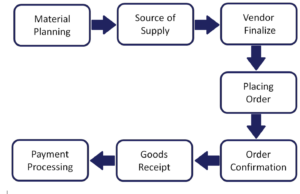There are many ways to improve business performance, and one of them is by practicing Value Supply Management. Buying is a mandatory practice regardless of the industry that the business operates in. Besides acquiring premium quality materials, we aim at effective time and cost management. Therefore, we call the process of buying materials and receiving services from vendors procurement.
SAP Material Management (SAP MM) helps cater to all of the above by assisting businesses to perform efficiently without friction.
In this blog, you will understand the fundamentals of purchasing and its types. As a beginner, you not only want to move ahead in the procurement journey but have a firm footing in the fundamentals.
Below are the Steps of a Simple Purchasing Process:
Material Planning: Identify the List of materials that need to be procured, the quantity required, the quality desired, and the expected delivery date.

- Identifying the Sources of Supply: Identify the vendors who can supply the desired materials.
- Finalizing the Vendor: Evaluate the different vendors and decide on a chosen vendor who meets all your criteria.
- Placing Order: Once the vendor is finalized, place the order with the specific vendor through a Purchase Order (PO).
- Confirm the Order: The vendor will issue a confirmation against the PO receipt once the PO is raised.
- Receive the Goods: The vendor will deliver the physical goods to your premises as agreed. If this is a planned delivery, the Goods Receipt will issue with respect to Inbound Delivery. However, regarding an unplanned delivery, the Goods Receipt can also be linked to the PO.
- Payment Processing: The vendor will send the invoice for the goods shipped. Invoice Verification will be carried out, and payment processing will happen based on the Incoterms.
Now LET’S get an idea of the different types of purchasing methods in practice;
- Consignment
- Stock Transport Order (STO)
- Sub-Contracting.
- Consignment
Consignment is when the supplier provides materials and stocks them on the company’s premises. The ownership of the stock, however, remains with the vendor. The store only transfers to the company’s books when it is removed from the consignment stock. The supplier will not be invoiced initially when they come into the company’s premises. The company is liable to pay the supplier only when the stock is withdrawn or consumed.
The steps to follow in a consignment procurement process are;
- Create Purchase Order (PO) with Item Category K.
- Goods Receipt against the consignment Purchase Order, Mvt Type 101 K, T Code MIGO-Goods Receipt.
- Transfer the ‘Consignment Stock’ to ‘Own Stock’ – Transfer Posting Mov Type – 411K, T-Code – MIGO.
- STO – Stock Transport Order
There are 2 STOs available as part of the Standard SAP Process, which is further divided into five types.
- Intra STO – Between different plants with the same company code.
- Inter STO – Between plants with two different company codes.
The One-Step Method.
- This is a process where the stock will move from one store location of a given plant to another store location of the same plant. Here, you need to use the T-Code – MB1B & MOV Type – 301.
- There will be no Purchase Order (PO), Goods Issue (GI), or Goods Receipt (GR) done directly. The materials will transfer with a Material Document.
The Two-Step Method.
- In this process, the stock will be moved from one store location of any given plant to another store location of the same plant. Here, we use the T-Code – MB1B & MOV Type – 303 & 305.
- There will be no Purchase Order (PO). But in this method, the Initial Goods Issue will be done in the GI store location (303), and Good Receipt (GR) will be done in the Goods Receiving store location. Move Type – 305, and the T-Code used is MB1B.
Without Delivery Method.
- There will be a PO created from the Receiving Plant towards the Supplying Plant using PO Doc Type – UB.
- Once the PO has been created, the stock will be transferred through T-Code – MB1B using MOV Type – 351.
- The Good Receipt (GR) will be done in MIGO with Ref to PO in T-Code – MIGO.
Intra STO.
- There will be a PO created from the Receiving Plant towards the Supplying Plant using PO Doc Type – UB.
- After this, an Outbound Delivery (OBD) will be created through T-Code – VL10B.
- Based on the OBD created, the Goods Issue (GI) will be done through T-Code – VL02N.
- Good receipt will be done in MIGO with Ref to PO in T-Code – MIGO.
Inter STO.
- There will be a PO created from the Receiving Plant towards the Supplying Plant using PO Doc Type – NB.
- After this, an OBD will be created through T-Code – VL10B.
- Based on the OBD created, a Goods Issue (GI) will be done through T-Code – VL02N.
- The Goods Receipt (GR) will be done in MIGO with Ref to PO in T-Code – MIGO.
- Sub-Contracting.
SAP Sub-contracting is a unique process where you send components to the vendor, assemble them, and manufacture the Final Product.
The subcontracting vendor returns the completely assembled, finished, or final product during goods receipt. The components issue from subcontract Stock.
The steps to follow in a sub-contracting procurement process are;
-
- Create Purchase Order with Item Category L.
- Create Transfer Posting with Movement Type 541 to issue the subcomponents to the vendor T-Code -ME2O/ MIGO.
- Goods Receipt for the finished product. T-Code – MIGO.
In this blog, I have outlined the basics of the procurement process for any industry. In my next blog, I will discuss the procurement method in further detail.
If you are interested in viewing similar articles, visit our blog here.
View our LinkedIn here.